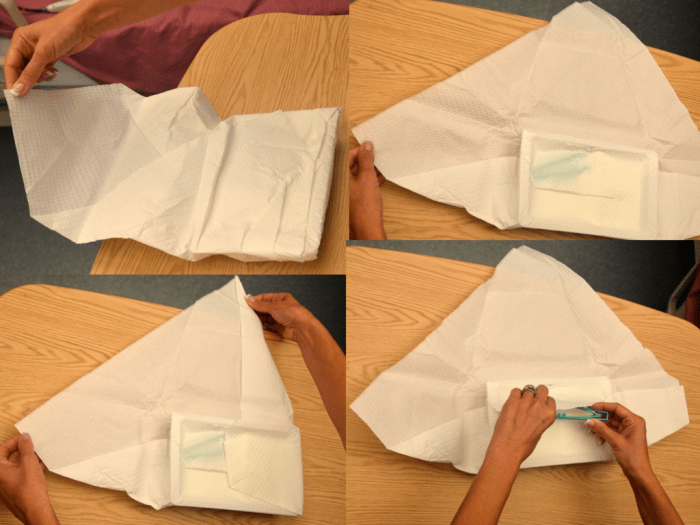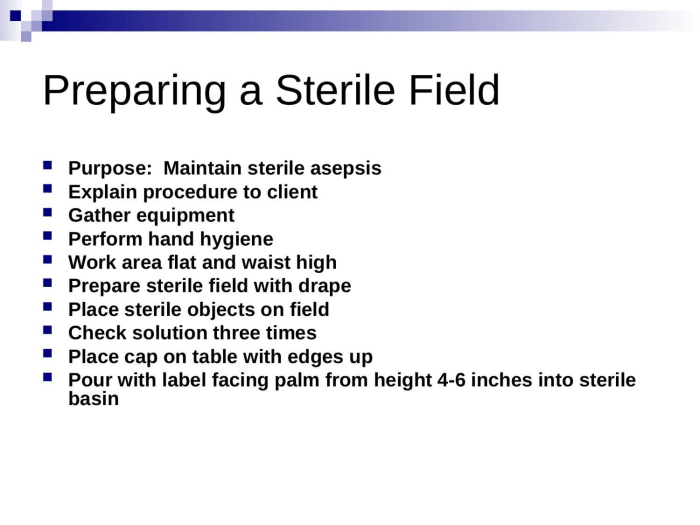A nurse is preparing a sterile field, a critical procedure that ensures the safety of patients during invasive procedures. Maintaining a sterile field is paramount to prevent infections and complications, and this guide will delve into the essential aspects of this crucial nursing practice.
This comprehensive guide will provide a thorough understanding of the concept, materials, and techniques involved in preparing and maintaining a sterile field. By adhering to these principles, nurses can effectively minimize the risk of contamination and safeguard patient well-being.
Definition of Sterile Field
A sterile field is a designated area that is free from microorganisms and their spores. It is created to prevent the contamination of medical devices, surgical instruments, and wounds during procedures.
Maintaining a sterile field is crucial to prevent surgical site infections and other complications. It involves establishing and adhering to strict protocols for handling and using sterile materials, equipment, and techniques.
Examples of sterile fields in nursing practice include:
- Operating room tables
- Dressing change trays
- Catheter insertion sites
Materials Required for Creating a Sterile Field

| Materials | Purpose | Quantity |
|---|---|---|
| Sterile gloves | Protect the hands of the healthcare provider | 1 pair |
| Sterile drapes | Create a barrier between the sterile field and the surrounding environment | As needed |
| Sterile gowns | Protect the body of the healthcare provider | 1 gown |
| Sterile masks | Prevent the spread of microorganisms from the healthcare provider to the patient | 1 mask |
| Sterile forceps | Handle sterile materials | As needed |
| Sterile scissors | Cut sterile materials | As needed |
Procedure for Preparing a Sterile Field

- Gather all necessary materials.
- Wash your hands thoroughly with soap and water.
- Don sterile gloves.
- Open the sterile package containing the drapes and gowns.
- Place the drapes on the work surface, creating a sterile field.
- Don the sterile gown and mask.
- Place the sterile instruments and materials on the sterile field.
- Maintain the integrity of the sterile field throughout the procedure.
Rationale:
- Washing hands removes transient microorganisms.
- Sterile gloves prevent contamination from the healthcare provider’s hands.
- Sterile drapes create a barrier between the sterile field and the surrounding environment.
- Sterile gowns and masks protect the healthcare provider and the patient from contamination.
- Maintaining the integrity of the sterile field prevents contamination of the sterile materials and instruments.
Maintaining a Sterile Field
Maintaining a sterile field requires constant vigilance and adherence to established protocols. Techniques include:
- Keeping the sterile field dry
- Avoiding contact between sterile and non-sterile items
- Not reaching across the sterile field
- Monitoring the sterile field for breaches
Potential contamination risks and prevention measures:
- Touching non-sterile objects:Use sterile gloves or forceps to handle non-sterile items.
- Moving sterile objects over non-sterile surfaces:Use a sterile drape to cover the non-sterile surface.
- Spilling fluids:Immediately clean up any spills with sterile gauze or towels.
- Personnel movement:Minimize personnel movement around the sterile field.
Troubleshooting Sterile Field Breaches: A Nurse Is Preparing A Sterile Field

Common causes of sterile field breaches:
- Touching the sterile field with non-sterile gloves
- Reaching across the sterile field
- Dropping sterile instruments or materials
- Personnel movement
Actions to take when a breach occurs:
- Stop the procedure immediately.
- Identify the source of the breach.
- Remove the contaminated item from the sterile field.
- Replace the contaminated item with a sterile one.
- Re-establish the sterile field.
Consequences of a sterile field breach:
- Surgical site infections
- Delayed wound healing
- Patient discomfort
- Increased healthcare costs
Minimizing risks:
- Educate healthcare providers on sterile technique.
- Establish clear policies and procedures for maintaining sterile fields.
- Monitor sterile fields regularly for breaches.
- Provide ongoing training and support to healthcare providers.
Commonly Asked Questions
What is the purpose of a sterile field?
A sterile field is an area that is free from microorganisms to prevent contamination during invasive procedures.
What are the key principles of maintaining a sterile field?
The key principles include using sterile materials, maintaining aseptic technique, and monitoring the field for breaches.
What are the consequences of a sterile field breach?
Breaches can lead to infections, complications, and delayed healing.
